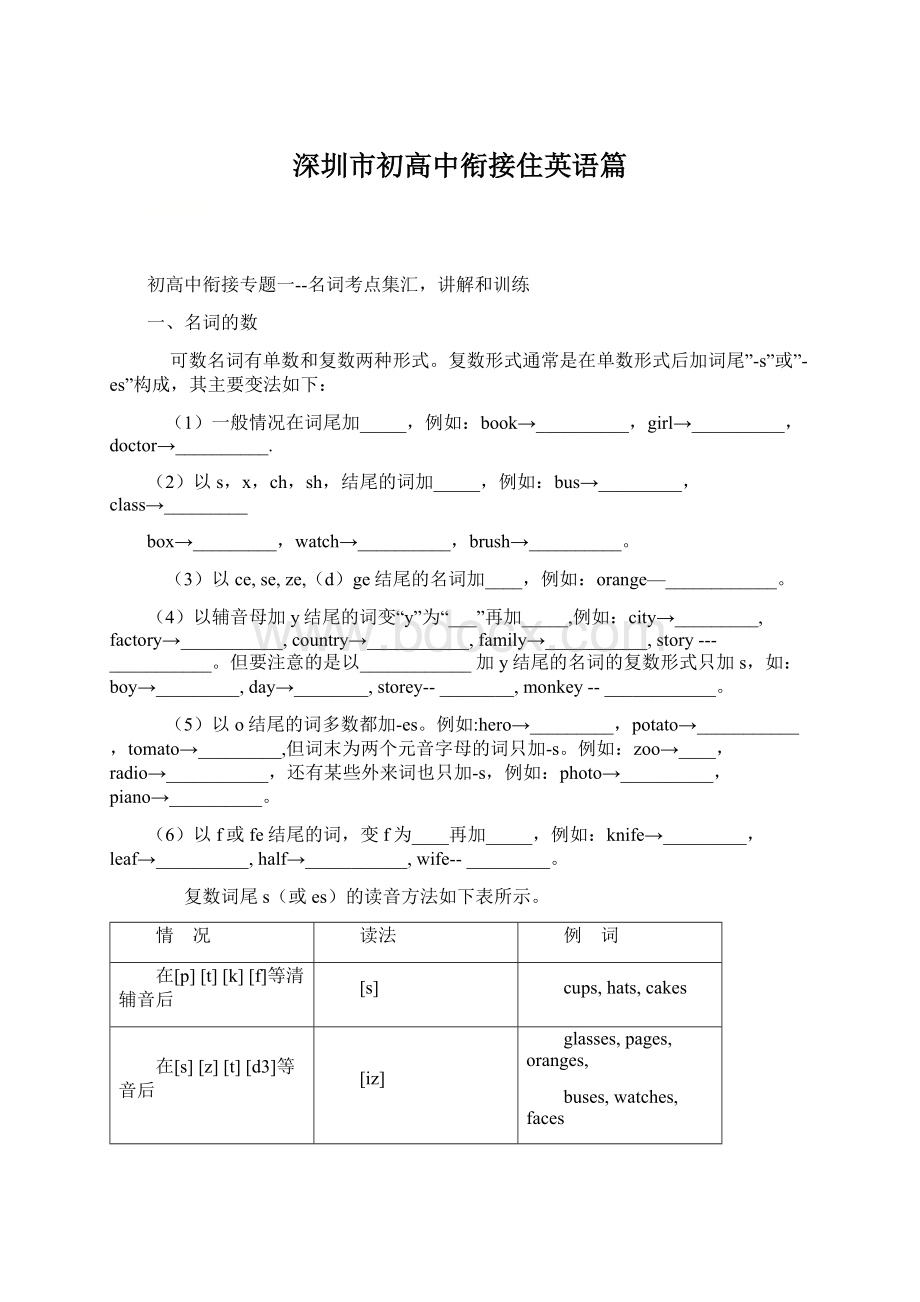深圳市初高中衔接住英语篇.docx
《深圳市初高中衔接住英语篇.docx》由会员分享,可在线阅读,更多相关《深圳市初高中衔接住英语篇.docx(16页珍藏版)》请在冰豆网上搜索。

深圳市初高中衔接住英语篇
初高中衔接专题一--名词考点集汇,讲解和训练
一、名词的数
可数名词有单数和复数两种形式。
复数形式通常是在单数形式后加词尾”-s”或”-es”构成,其主要变法如下:
(1)一般情况在词尾加_____,例如:
book→__________,girl→__________,doctor→__________.
(2)以s,x,ch,sh,结尾的词加_____,例如:
bus→_________,class→_________
box→_________,watch→__________,brush→__________。
(3)以ce,se,ze,(d)ge结尾的名词加____,例如:
orange—____________。
(4)以辅音母加y结尾的词变“y”为“___”再加_____,例如:
city→_________,factory→___________,country→___________,family→___________,story---___________。
但要注意的是以____________加y结尾的名词的复数形式只加s,如:
boy→_________,day→________,storey--________,monkey--____________。
(5)以o结尾的词多数都加-es。
例如:
hero→_________,potato→___________,tomato→_________,但词末为两个元音字母的词只加-s。
例如:
zoo→____,radio→___________,还有某些外来词也只加-s,例如:
photo→__________,piano→__________。
(6)以f或fe结尾的词,变f为____再加_____,例如:
knife→_________,leaf→__________,half→___________,wife--_________。
复数词尾s(或es)的读音方法如下表所示。
情 况
读法
例 词
在[p][t][k][f]等清辅音后
[s]
cups,hats,cakes
在[s][z][t][d3]等音后
[iz]
glasses,pages,oranges,
buses,watches,faces
在[b][d][g][v]等浊辅音后
[z]
beds,dogs,cities,knives
(7)少数名词有不规则的复数形式,例如:
man→________,woman→_________,tooth→_________,foot→________,child→__________,mouse→_________,ox--________,goose--____________。
【注意】与man和woman构成的合成词,其复数形式也是-men和-women。
例如:
two____________(Englishman),five____________(gentleman),three___________(German)。
man,woman等作定语时,它的单复数以其所修饰的名词的单复数而定,如:
5个女老师:
_____________________。
有个别名词单复数一样,例如:
中国人____________,日本人____________,绵羊_________,鹿_________,鱼__________等。
(8)单数形式但其意为复数的名词有:
人们__________,警察___________,牛________等。
(9)数词+名词作定语时,这个名词一般保留单数形式,中间加连字符。
例如一个8岁的男孩:
___________________,一次10分钟的行程___________。
(10)还有些名词仅有复数形式,如:
裤子____________,衣服__________,筷子_____________,眼镜__________,货物_________,剪刀___________,指南针______________。
(11)只用作单数的复数形式的名词有:
physics,mathematics/maths,politics,theUnitedStates,NiagaraFalls,news.
2.不可数名词“量”的表示方法
在英语中,不可数名词如果要表示“量的概念”,可以用以下两种方法:
(1)用much,alittle,alotof/lotsof,some,any等表示多少,例如:
Therichmanhas____________(很多)money.
Thereis_________(一些)milkinthebottle.
Isthere_________waterintheglass?
Idon'tlikewinterbecausethere's___________(太多)snowandice.
(2)用apieceof这类定语,例如:
一张纸_______________,一块蛋糕_______________,一瓶橘子汁_________________,一杯牛奶______________ 一袋米_____________,三袋米__________________.
二、名词的所有格
名词所有格,用来表示人或物的所有,以及领属关系。
1.表示有生命的名词的所有格其单数形式是加's,其复数形式是s',例如:
爸爸的鞋_______________,学生宿舍_______________。
2.如其结尾不是s的复数形式仍加's,如:
儿童节__________________,妇女节__________________,男厕所______________。
3.在表示时间、距离、长度、重量、价格、世界、国家等名词的所有格要用's,例如:
10英里的旅程___________________,aboat'slength,10美元的价值___________________。
4.名词所有格后面有指地点等的名词时, 有的在习惯上可以省略。
如:
医生诊所________________,理发店_______________,我姨妈家_____________,老师的办公室_____________,斯密斯先生的家___________.
5.无生命名词的所有格则必须用of结构,例如:
一张中国地图________________,这学期末__________________,我们国家的首都__________________,教室的窗户_______________________,书的标题__________________,海底_________________.
6.双重所有格,例如:
我爸爸的一个朋友__________________,我妹妹的两个同学__________________________。
【注意】
如果两个名词并列,并且分别有's,则表示“分别有”,例如:
John'sandMary'srooms(约翰和玛丽各有一间,共两间);Tom'sandMary'sbikes(两人各自的自行车)。
两个名词并列,只有一个's,则表示“共有”,例如:
JohnandMary'sroom(约翰和玛丽共有一间);TomandMary'smother(即Tom与Mary是兄妹)。
【演练1】单选题
1.---Wherehaveyoubeen,Tim?
---I’vebeento______.
A.theHenryhouse B.theHenryfamilyC.TheHenry’shome D.Henry’s
2.Youlookedforittwice,butyouhaven’tfoundit.Whynottry____.
A.threetimes B.athirdtime C.thethirdtime D.once
3.---Theyarethirsty.Willyoupleasegivethem______?
---Certainly.
A.somebottlesofwaters B.somebottlesofwater
C.somebottleofwater D.somebottleofwaters
4.Mikehurtoneofhis______intheaccidentyesterday.
A.tooth B.feet C.hand D.ear
5.Thereissome_______ontheplate.
A.cakes B.meat C.potato D.pears
6.Theyaregoingtofly_______toBeijing.
A.Germen B.Germany C.Germanys D.Germans
7.The______hastwo_______.
A.boys;watches B.boy;watch C.boy;watches D.boys;watch
8.Thelittlebabyhastwo_______already.
A.tooth B.tooths C.teeth D.teeths
9.What’syour_______forbeinglateagain?
A.idea B.key C.excuse D.news
10.---It’sdangeroushere.We’dbettergooutquickly.
---ButIthinkweshouldlet_______gooutfirst.
A.womanandchildren B.womenandchild
C.womanandchild D.womenandchildren
11.Aretheygoingtohaveapicnicon_______?
A.Children’sDay B.Childrens’sDayC.ChildrensDay D.ChildrenDay
12.Wherearethestudents?
Aretheyin_______?
A.theRoom406 B.Room406 C.the406Room D.406Room
【演练2】语法填空
1.Alwaysremembertoputsuchdangerousthingsas__________(knife)outofchildren’sreach.
2.Dr.Smithisgoingtopulloutoneofmy_________(tooth).
3.Inmyopinion,itiswrongtocheatin_____________(examine)becauseitbreakstherulesofschools.
4.Upon___________(arrive),webegantoworkimmediately.
5.Since“Lifeisastage”,weareactuallyallactorsand_____________(act).
6.Therearemorevisiblechangesinourgesturesandfacial____________(express).
7.LangLangisaworld-classyoung__________(piano)whogrewupinShenyang.
【演练3】单句改错
1.Ihavebeenthereacoupleoftime.
2.WhenyouvisitLondon,oneofthefirstthingyouwillseeisBigBen.
3.Mr.WanggaveussomeadvicesonhowtorememberEnglishwords.
4.IhavenotimetotakeexercisebecauseIhavealotofhomeworkstodo.
5.Thishappenedfourandahalfcenturyago.
6.Morecarewouldinsureyouagainstmakingsomuchmistakes.
7.It’saboutanhourdrivefromheretomyoffice.
8.LiMing,athree-years-oldboy,isverylovely.
9.Wearehavingdinneratmyaunttonight.
10.Inourschool,thereisanewlabbuildingwithlotsofteachingequipmentsinit.
【演练4】短文改错
BornonAugust23,1988inAmerica,JeremyShu-HowLinisanprofessionalbasketballplayerwiththeHustonRocketsoftheNationalBasketballAssociation(NBA).But,tosomedegree,manyChinesefansandcoachstakehimasaChineseguyoratleastarewillingtoimaginehimaChinesejustbecausehehasatypicalChinesefaceandhisparentwereborninChina.JeremyLinhasrecentlybecomesuccessandattractedtheworldattention,whichgivesChinesepeoplealotofimaginationsandpride.Asweknow,inmostpeopleeye,Jeremyisamiracle.
InJune,2012,whenJeremytookhisthirdtriptoChina,alargecrowdcametomeethim,amongwhomtherewerevariousfansincludingsomefamily,somechildrenandevensomewomanplayers.Theybroughtcamerastotakephotoeswiththeiridol.Jeremyhadfunwithhissupporterandexpectedtocomebackagain.
初高中衔接专题二:
形容词、副词考点集汇,讲解和训练
1.形容词的用法
(1)形容词在句中作定语,表语,宾语补足语。
例如:
The____________________(帅哥)attractedalltheladiespresent.
Thefish________________(变质了).
Thefilmisboth__________(move)and____________(有教育意义).
Wekeepourclassroom___________________(干净整洁).
(2)形容词修饰something,anything,nothing,everything等不定代词时,形容词放在名词后面。
Ihave___________________(重要的事情)totellyou.
Isthere____________________(有趣的事情)inthefilm.
(3)以-ly结尾的形容词
以-ly结尾的词多为副词。
但friendly________,deadly________,lovely______,lonely________,likely_______,lively______,ugly______,brotherly________,daily_________等仍为形容词。
(4)the+形容词表示一类人或物:
年轻人_____________,老人_____________,富人____________,穷人___________,盲人_____________,死人___________,活人______________
富人应该帮助穷人。
__________________________________________.
2.副词的用法
(1)副词在句中可作状语,表语和定语。
Hestudies________________(非常努力).
_______________(这里的生活)isfullofjoy.
Whenwillyou____________(回来)?
副词按其用途和含义可分为下面五类:
1)时间副词
时间副词通常用来表示动作的时间。
常见的时间副词有:
nowtoday,tomorrow,yesterday,before,late,early,never,seldom,sometimes,often,usually,always等。
例如:
他经常上学迟到。
___________________________________.
她从未去过北京。
___________________________________.
2)地点副词
地点副词通常用来表示动作发生的地点。
常见的地点副词有:
here,there,inside,outside,home,upstairs,downstairs,anywhere,everywhere,nowhere,somewhere,down,up,off,on,in,out等。
例如:
在回家的路上,我遇到一位老友。
___________________________________.
把你的名字写在这儿。
______________________________________.
3)方式副词
方式副词一般都是回答“怎样的?
”这类问题的,其中绝大部分都是由一个形容词加词尾-ly构成的,有少数方式副词不带词尾-ly,它们与形容词同形。
常见的方式副词有:
anxiously,badly,bravely,calmly,carefully,proudly,rapidly,suddenly,successfully,angrily,happily,slowly,warmly,well,fast,,quickly,hard,alone,high,straight,wide等。
例如:
老人慢慢走回家。
________________________________.
请认真听老师讲。
_________________________________________.
4)程度副词
程度副词多数用来修饰形容词和副词,有少数用来修饰动词或介词短语。
常见的程度副词有:
much,(a)little,abit,very,so,too,enough,quite,rather,pretty,greatly,completely,nearly,almost,deeply,hardly,partly等。
例如:
她的发音非常棒。
___________________________________.
我深深地被这部电影感动了。
____________________________________.
5)疑问副词是用来引导特殊疑问句的副词。
常见的疑问副词有:
how,when,where,why等。
例如:
你目前学习怎么样?
____________________________________________?
你在哪里找到手机的?
___________________________________________?
(2)部分常用副词的用法
1)very,much
这两个副词都可表示“很”,但用法不同。
Very用来修饰形容词和副词的原级,而much用来修饰形容词和副词的比较级。
例如:
Sheisa__________nicegirl
I’mfeeling__________betternow.
Much可以修饰动词,而very则不能。
例如:
Idon’tliketheidea_________.Theydidnottalk________.
2)too,either
这两个副词都表示“也”,但too用于肯定句,either用于否定句。
例如:
Shecandance,andIcandance,_______.
Ihaven’treadthebookandmybrotherhasn’t________.
3)already,yet
already一般用于语肯定句,yet一般用于否定句。
例如:
Hehas_________left.
Haveyouheardfromhim________?
Hehasn’tanswered_________.
4)so,neither
so和neither都可用于倒装句,但so表示肯定,neither表示否定。
Mybrotherlikesfootballand______________I.
Mybrotherdoesn’tlikedancingand________________I.
3.形容词和副词的比较级和最高级
(1)两个人或事物的比较时(不一定每一方只有一个人或一个事物),用比较级。
Ourteacheris_